The form of fetuin has not been determined. This material has not been sequenced. The minimum allowable sialic acid content is 0.5%. The molecular weight is approximately 44,200 daltons. The starting material for this product has a molecular weight of approximately 48,400 including an estimated 8.7% sialic acid. According to the UniPro values for each, the Fetuin-B molecular weight is calculated at 42,663 while the Fetuin-A is 38,419.
A4781
Asialofetuin from fetal calf serum
Type I (Sigma designation)
Sinónimos:
Asialofetuin
Seleccione un Tamaño
Seleccione un Tamaño
About This Item
Productos recomendados
origen biológico
bovine (calf) serum
Nivel de calidad
tpo
Type I (Sigma designation)
Formulario
powder
impurezas
salt, essentially free
≤0.5% N-acetylneuraminic acid
solubilidad
0.85% sodium chloride: soluble 1 mg/mL
temp. de almacenamiento
2-8°C
¿Está buscando productos similares? Visita Guía de comparación de productos
Descripción general
Aplicación
- to quantitate the plant Ricin toxin′s B subunit (RTB) lectin activity in β-phaseolin signal peptide (P)–proinsulin gene (INS)–RTB plants by enzyme-linked immunosorbent assay (ELISA)[2]
- quantitate VP7:RTB fusion protein in transformed potato tissues by ELISA[3]
- as a glycoprotein substrate to measure the receptor-binding activity of recombinant RTB and NSP490–RTB fusion proteins[4]
- to study the nature of the interaction between ferritin and the placenta[5]
Acciones bioquímicas o fisiológicas
Nota de preparación
Código de clase de almacenamiento
11 - Combustible Solids
Clase de riesgo para el agua (WGK)
WGK 3
Punto de inflamabilidad (°F)
Not applicable
Punto de inflamabilidad (°C)
Not applicable
Equipo de protección personal
Eyeshields, Gloves, type N95 (US)
Elija entre una de las versiones más recientes:
Certificados de análisis (COA)
¿No ve la versión correcta?
Si necesita una versión concreta, puede buscar un certificado específico por el número de lote.
¿Ya tiene este producto?
Encuentre la documentación para los productos que ha comprado recientemente en la Biblioteca de documentos.
Los clientes también vieron
-
To wich fetuin corresponds your product A4781 (Asialofetuin from fetal calf serum). Is it Protein Fetuin-A ? Uniprot entry: P12763 FETUA_BOVIN or protein Fetuin-B ? Uniprot entry: Q58D62 FETUB_BOVIN Do you have de amino acid sequence?
1 answer-
Helpful?
-
-
Hi, What is the difference in Type 1 versus Type II asialofetuin
1 answer-
The difference between the Type I and Type II Asialofetuin products does not represent any kind of biochemical or functional difference. These indicate different methods of production and purification. The Type II option, product A1908, utilizes neuraminadase in an enzymatic cleavage step. The Type I, product A4781, uses a proprietary modification of that described in Spiro, R.G., J. Biol. Chem., 235, 2860 (1960).
Helpful?
-
Active Filters
Nuestro equipo de científicos tiene experiencia en todas las áreas de investigación: Ciencias de la vida, Ciencia de los materiales, Síntesis química, Cromatografía, Analítica y muchas otras.
Póngase en contacto con el Servicio técnico










